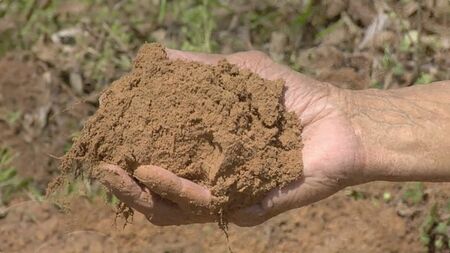Silt
Silt is a clastic sedimentary rock consisting of consolidated grains. The grains need to have a diameter from 2 micrometer to 63 micrometer. The grains of this rock are coarser than those of clay and less coarse than those of sand. In the field this soil type is hard to distinguish from clay. By adding water and rubbing the found soil in your hand one can distinguish silt from clay. With silt still some loose particles can be felt and with clay these particles are not present.
Sub-categories
Within the grain size of silt there are some subcategories to characterize the types of silt. Following table describes them.
| Type | Grainsize |
|---|---|
| Coarse silt | > 0.02 - ≤ 0.063 mm |
| Medium coarse silt | > 0.0063 - ≤ 0.02 mm |
| Fine silt | > 0.002 - ≤ 0.0063 mm |
Silt or clay?
There are several tests you can do to determine if the soil you're dealing with is Silt or Clay.
Dry strength test
Roll the soil up to a ball and let it dry completely. Then, once the soil is dry, try crushing the soil with your fingers. If it crushes easily, it's more likely to be silt. If it takes effort to crush, it's more likely to be clay.
Dilatency test
Because the permeability of clay and silt are different, we can use this factor as an identification test. This is done my mixing a small amount of soil with water in the palm of your hand. Once this is done, tap the back of your hand or shake the soil inside your hand. If it is Silty soil, a quick reaction will occur where water will rise to the surface and gives the soil a glistening appearance. In the case of clay, the water will be quickly absorbed into the clay again and leave the soil with a dull look. There can be several reaction speeds / testresults.
Plasticity test
This test makes use of the molding characteristic of clay. This is done by taking a bit of moist soil, rolling it into a ball and then try to roll it into a thin 3mm long thread. If the soil holds clay this should pose no problems, whereas with silt the soil will crack / it should be almost impossible to roll the soil into a thin thread and still support its own weight.
Dispersion test
For the dispersion test, you can add some soil to a flask or jar with water and shake it up, so that the soil particles will be suspended in the water. Then, you can determine rough percentages of sand, silt and clay by seeing how long it takes for particles to settle. Sand particles will settle at around 15 seconds, silt particles will settle at around 30 seconds and clay particles can remain suspended for hours.
References
- NEN-EN-ISO 14688-1:2019
